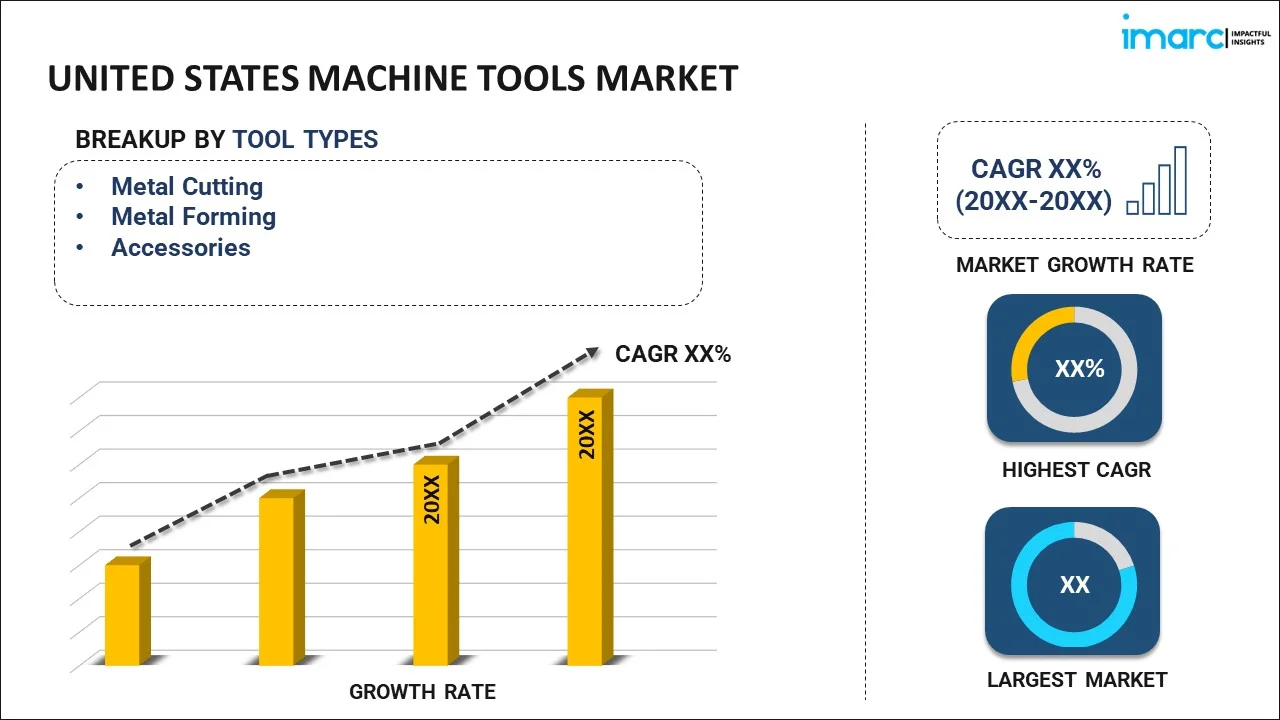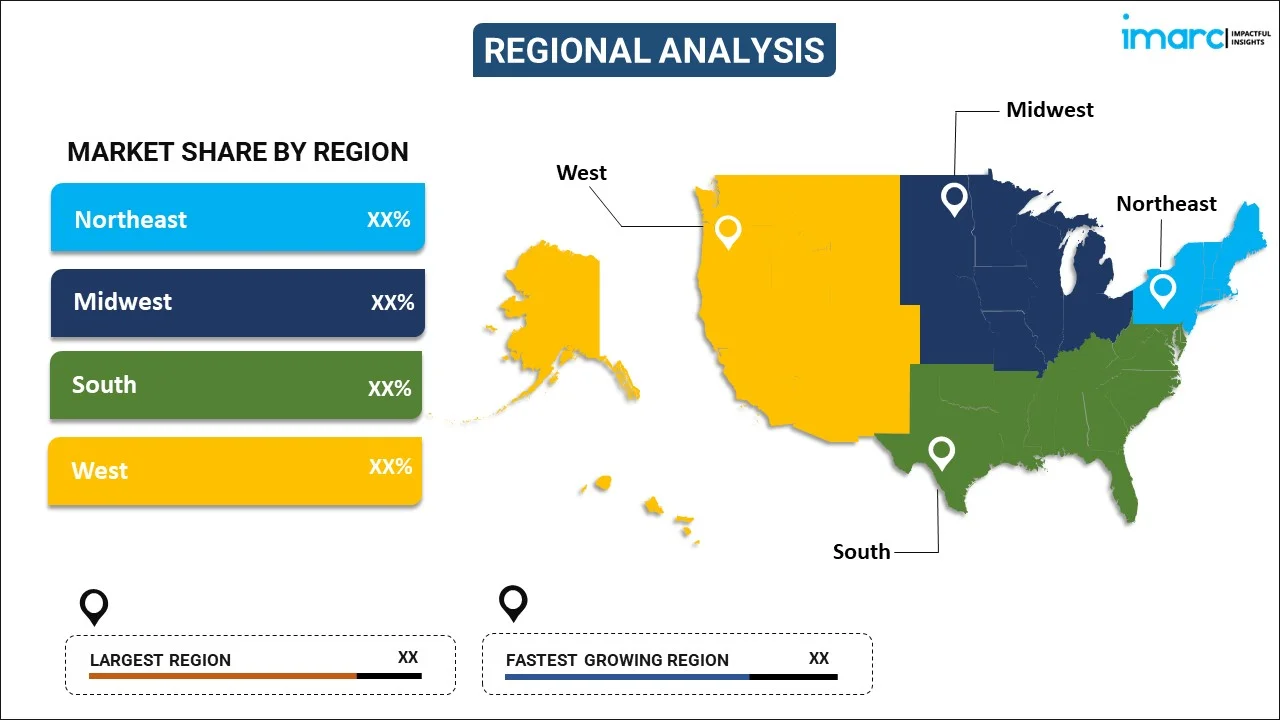
United States Machine Tools Market Report by Tool Type (Metal Cutting, Metal Forming, Accessories), Technology Type (Conventional, CNC (Computerized Numerical Control)), End Use Industry (Automotive, Aerospace and Defense, Electrical and Electronics, Consumer Goods, Precision Engineering, and Others), and Region 2026-2034
United States Machine Tools Market Size, Share & Analysis
The United States machine tools market size reached USD 12.2 Billion in 2025. Looking forward, IMARC Group expects the market to reach USD 16.8 Billion by 2034, exhibiting a growth rate (CAGR) of 3.58% during 2026-2034. The market is witnessing consistent growth with increasing demand for precision engineering, automation, and digitally integrated manufacturing systems. Industry trends involve the implementation of Industry 4.0 technologies, hybrid additive-subtractive machining, and energy-efficient tools. Aerospace, automotive, and medical devices sectors are pushing the demand for advanced tools. Reshoring activities and changing requirements drive the market. These factors are driving modernization across manufacturing sectors, boosting investments in CNC equipment and smart technologies, and strengthening the overall competitiveness of domestic production in the market.
|
Report Attribute
|
Key Statistics
|
|---|---|
|
Base Year
|
2025
|
|
Forecast Years
|
2026-2034
|
|
Historical Years
|
2020-2025
|
|
Market Size in 2025
|
USD 12.2 Billion |
|
Market Forecast in 2034
|
USD 16.8 Billion |
| Market Growth Rate 2026-2034 | 3.58% |
Access the full market insights report Request Sample
Machine tools operate using numerical control, which helps in achieving maximum product uniformity. These tools assist in cutting, shaping, forming, drilling, grinding, abrading, and nibbling metals or other hard materials. They also aid in minimizing human efforts required during cutting and enhancing the overall productivity.
The escalating demand for fabricated metals in the United States represents one of the key factors stimulating the market growth. Moreover, a significant demand for electric vehicles (EVs), autonomous cars and self-driven trucks is increasing the utilization of machine tools in the country. Apart from this, advancements in hardware and software components of computer numerical control (CNC) machines, coupled with the introduction of multi-axis and robotic arms, are driving the market growth. Furthermore, the setting up of various manufacturing plants is providing lucrative opportunities to players in the United States.
United States Machine Tools Market Trends:
Integration of Industry 4.0 and Smart Manufacturing
Industry 4.0 technologies are transforming the United States machine tools industry. Smart manufacturing protocols allow factories to incorporate connected devices, cloud platforms, and real-time analytics to improve precision and operation efficiency. Sensor network-based predictive maintenance reduces downtime and optimizes equipment lifespan. For instance, in April 2025, ANCA introduced its proprietary Motor Temperature Control (MTC) technology, eliminating heat growth problems in tap making to provide greater accuracy, thread quality, tool life, and production repeatability. Moreover, robotics and automated systems based on artificial intelligence (AI) are also enhancing productivity while minimizing dependence on labor. These developments are promoting increased agility in manufacturing, particularly as firms adopt reconfigurable systems to respond to changing product needs. This shift to digitalized operations highlights the transformation of manufacturing in the nation. Consequently, the United States machine tools market outlook continues to be optimistic. Advancements in connectivity and automation are driving production models of the future, highlighting broader Industry 4.0 uptake. These technological capabilities drive the United States machine tools market growth and make the nation a leader in contemporary manufacturing. This trend directly influences the United States machine tools market share and size.
Growth in Demand for Additive and Hybrid Machining Solutions
Additive and hybrid machining technologies are revolutionizing the way complex parts are produced across industries. In the United States, this consolidation of additive and subtractive processes within a single platform enhances manufacturing efficiency and facilitates complex designs. Hybrid machines, which can 3D-print parts and finish them using precise cutting, minimize tool changeovers, lead times, and material waste. Such versatility is particularly precious in industries such as aerospace, defense, and healthcare, where component precision and speed are critical. Engineers are increasingly using these machines for prototyping and series of limited production. As new material and printing technologies evolve, hybrid tool demand is likely to grow. This trend is contributing significantly to the United States machine tools market demand. At the same time, it is widening the technological base covered in the United States machine tools market forecast. As hybrid machining expands, the United States machine tools market analysis projects rapid innovation that will fortify the nation's machine tools market share and future prospects.
Transition Towards Energy Efficiency and Green Manufacturing
Sustainability objectives are pushing for a high focus on energy efficiency in the United States machine tools industry. Companies are making a transition towards servo drives, regenerative energy systems, and high-end drive technology to minimize electricity use. Environmental factors are also driving the application of biodegradable lubricants and closed-loop coolant recycling, minimizing resource consumption and pollution. Both cost savings and eco-friendliness underpin these transitions, making green manufacturing desirable and necessary. Regulators and consumers are forcing the pace of cleaner production, and machine tool manufacturers are producing greener products in response. As lean manufacturing converges with sustainability, contemporary machine tools are being developed to provide performance without compromising environmental ambitions. This shift corresponds with the shifting values of customers and government policies on decarbonization. In this regard, the United States machine tools market trends indicate a continued shift towards responsible production. The United States machine tools market size and forecast reflect this shift, bolstering the industry’s competitiveness and broader market share.
United States Machine Tools Market Opportunities:
The United States machine tools market offers strong opportunities fueled by changing manufacturing requirements, advancements in technology, and government support for local production. With industries embracing automation and precision engineering, the need for CNC machines and digitally integrated tools rises. Opportunities are arising in areas like aerospace, defense, medical devices, and renewable energy, where complex component manufacturing and close tolerances are essential. The reshoring of production activities, facilitated by federal programs, is also driving investments in advanced machining facilities. Further, the expansion of small and medium-sized businesses (SMEs) dealing with specialized, short-run manufacturing is generating demand for flexible, space-saving, and efficient machine tools. With increasing emphasis on sustainability, producers providing energy-efficient and environmentally friendly machinery are poised to gain. Educational alliances and workforce development initiatives are also releasing opportunities through filling the skills gap. These conditions jointly improve the United States machine tools market prognosis and facilitate long-term growth and development.
United States Machine Tools Market Challenges:
Although the United States machine tools market is highly promising, it also has a number of sensitive challenges that need careful handling. One such sensitive area is the steep capital outlay for advanced equipment, which can make such technology inaccessible to small and medium-sized manufacturers. Furthermore, the lack of skilled labor that is able to handle and maintain highly advanced equipment still impacts productivity. It may also be challenging to keep pace with swift technological changes since frequent upgrades and training are needed to remain competitive. Raw material price volatility and worldwide supply chain disruptions could have additional effects on production planning and cost effectiveness. Environmental compliance and changing regulatory requirements increase the complexity of operations that demand continuous investment in sustainable operations. In addition, sharp international competition forces domestic producers to innovate continuously at the same time as they are cost-conscious. Albeit challenging, aggressive strategies centered on developing the workforce, digitalization, and supply chain resilience can underpin continued growth in United States machine tools market.
Key Market Segmentation:
IMARC Group provides an analysis of the key trends in each sub-segment of the United States machine tools market report, along with forecasts at the country and regional level from 2026-2034. Our report has categorized the market based on tool type, technology type and end use industry.
Breakup by Tool Type:

To get detailed segment analysis of this market Request Sample
- Metal Cutting
- Metal Forming
- Accessories
Breakup by Technology Type:
- Conventional
- CNC (Computerized Numerical Control)
Breakup by End Use Industry:
- Automotive
- Aerospace and Defense
- Electrical and Electronics
- Consumer Goods
- Precision Engineering
- Others
Breakup by Region:

To get detailed regional analysis of this market Request Sample
- Northeast
- Midwest
- South
- West
Competitive Landscape:
The competitive landscape of the industry has also been examined along with the profiles of the key players.
Latest News and Developments:
- April 2025, ANCA CNC Machines introduced its Motor Temperature Control (MTC) system to improve tap production accuracy by minimizing spindle thermal growth error. At the same time, EMAG unveiled its new compact WPG 7 grinding machine to North America, guaranteeing speedy setup and reliable accuracy for small parts up to 250 mm in length.
- February 2025, Murata Machinery USA launched the MT1065EX twin-spindle CNC turning center, designed for bar-feed use. Making its debut at PMTS 2025, the machine includes two turrets, Y-axis capability, thermal compensation, and compact design to increase accuracy, flexibility, and productivity in high-volume and high-mix machining situations.
- September 2024 – Okuma to exhibit its newest CNC machines and automation solutions at IMTS 2024 in Chicago. Key features include live demonstrations of the MU-6300V-L 5-axis vertical machining center, horizontal lathes, multitasking systems, and cutting-edge automation solutions such as the SmarTwin Cell and collaborative robots for increased manufacturing efficiency.
Report Coverage:
| Report Features | Details |
|---|---|
| Base Year of the Analysis | 2025 |
| Historical Period | 2020-2025 |
| Forecast Period | 2026-2034 |
| Units | Billion USD |
| Segment Coverage | Tool Type, Technology Type, End Use Industry, Region |
| Region Covered | Northeast, Midwest, South, West |
| Customization Scope | 10% Free Customization |
| Post-Sale Analyst Support | 10-12 Weeks |
| Delivery Format | PDF and Excel through Email (We can also provide the editable version of the report in PPT/Word format on special request) |
Key Questions Answered in This Report
The United States machine tools market was valued at USD 12.2 Billion in 2025.
We expect the United States machine tools market to exhibit a CAGR of 3.58% during 2026-2034.
The emerging trend of automation, along with the growing utilization of machine tools to increase the overall productivity and improve the efficiency of various products, is primarily driving the United States machine tools market.
The sudden outbreak of the COVID-19 pandemic had led to the implementation of stringent lockdown regulations across the nation, resulting in the temporary closure of numerous end-use industries for machine tools.
Based on the tool type, the United States machine tools market can be bifurcated into metal cutting, metal forming, and accessories. Currently, metal cutting holds the majority of the total market share.
Based on the technology type, the United States machine tools market has been segmented into conventional and CNC (Computerized Numerical Control), where CNC (Computerized Numerical Control) currently exhibits a clear dominance in the market.
Based on the end use industry, the United States machine tools market can be divided into automotive, aerospace and defense, electrical and electronics, consumer goods, precision engineering, and others. Currently, automotive accounts for the largest market share.
On a regional level, the market has been classified into Northeast, Midwest, South, and West.
Need more help?
- Speak to our experienced analysts for insights on the current market scenarios.
- Include additional segments and countries to customize the report as per your requirement.
- Gain an unparalleled competitive advantage in your domain by understanding how to utilize the report and positively impacting your operations and revenue.
- For further assistance, please connect with our analysts.
 Request Customization
Request Customization
 Speak to an Analyst
Speak to an Analyst
 Request Brochure
Request Brochure
 Inquire Before Buying
Inquire Before Buying




.webp)




.webp)












